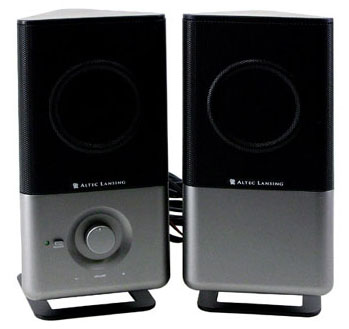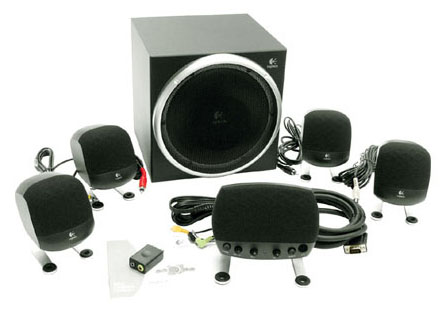Buyer's Guide - Entry Level, October 2004
by Jarred Walton on October 6, 2004 12:05 AM EST- Posted in
- Guides
Speakers
Depending on what you want to do with your computer, there are a few different options in the sound department. We will leave it to you to decide which option fits your needs best.Office Recommendation: None/Headphones
Price: $0
If you are only interested in an office computer, you really have no need for actual speakers. Save your pennies for something that you will actually use, as the Windows beeps are not going to be missed. Besides, if you need sound at some point, you probably have a pair of headphones that you can plug into the computer. Should you change your mind, buying a set of speakers and hooking them up is about as easy an upgrade as you can find.

Office Recommendation 2: Altec Lansing 220 2.0 Speakers
Price: $16 shipped
If you want to listen to the occasional CD while you work on your taxes, or maybe play a few games now and then, these speakers will work well without costing a lot. They are pretty anemic when compared to something like a set of Klipsch ProMedia Ultra 5.1's, but at less than one twentieth the price, you cannot expect them to compete with Klipsch. You could also opt for a setup that includes a subwoofer, like the Creative SBS330 2.1, but then you are getting close to the cost of the last option with much lower quality.

Gamer Recommendation: Logitech Z-640 5.1 Speakers
Price: $56 shipped
If it seems like almost every Guide that we have written lately includes these speakers as an option, just consider that a sign of their quality. There may be competing speaker setups from other companies, but we have yet to find one that can match the price and quality of the Z-640s. Even Logitech has come out with several new inexpensive 5.1 setups that cannot beat them. There are better sounding speakers out there, but they typically cost three times as much, if not more. These speakers can get plenty loud, and we can personally attest to the fact that they work well while playing games and watching movies. Some of us have even chosen to forgo expensive stereo components and just stick with these on our entertainment system. The only thing that they really lack is a remote control, but that's just us being greedy.










53 Comments
View All Comments
kmmatney - Wednesday, October 6, 2004 - link
We are going completely small form factor at my office, using either the ASUS Terminator or, lately, ASUS T2-P with Celeron-D. They've all worked great, and no problems using on-board graphics.The ASUS Terminator + Duron is simply an incredible value. The ASUS T2-R is also nice, with ATI Radeon 9100 graophics.
kherman - Wednesday, October 6, 2004 - link
kherman - Wednesday, October 6, 2004 - link
Left kinda confused. I see alot of areas I simply didn't like. In particular, for a true Office rig, where data intergretty is VERY important, I'd suggest 2 hard drives and a software RAID solution. Same total cost for hard drives, but it's justfied in terms of budget. Spend the same amount. for gaming, go for fast loading. For office, go for redundancy. The Office rig would actually have more alloted to the hard drive, but isn't that the critical component in an office rig?I say this every time I see a write up. You really need to start mentioning it, even if it's simpyl an alternative office solution that costs more. Most people using a PC for home office use, don't have a server running RAID 5 available and it almost seems as though it's an assumption.
Other than this, I loved that article. Also, for home office, I can't see recomending 17" monitors. You need to generally run higher resolution and see more of the screen to be efficient in a home office.
To be honest, I have to say that "a "budget rig" for office shouldn't be much cheaper than he gaming rig. Monitors and redundancy are important factors here where gaming rigs need a killer video card.
Please consider this in the future.
boomerang - Wednesday, October 6, 2004 - link
Very happy with the more in-depth explanations and choices given in the guide. I very much depend on these guides when building systems.You are to be commended for a job well done!
iversonyin - Wednesday, October 6, 2004 - link
since we in the entry level budget, why not get a generic case+ PS. generic case usually got for ~$35i would not run XP with 256 MB RAM even its only for office use. IMO
PrinceGaz - Wednesday, October 6, 2004 - link
On the last page in the Additional Alternatives table, the Power Supply Upgrade has the wrong item name.Iger - Wednesday, October 6, 2004 - link
Thanks for the nice guide, I love explanations too :)About monitors - there actually are Samsung 795 DF ones, which handle 1280x1024@75 for a few more $ :)
Gholam - Wednesday, October 6, 2004 - link
$14, Bayfield is just way too expensive - why not use a D865GVHZ if you're determined to go Intel?Gholam - Wednesday, October 6, 2004 - link
$14, Bayfield is just way too expensive - why not use a D865GVHZ if you're determined to go Intel?Scarceas - Wednesday, October 6, 2004 - link
I've had seen at least one business app that didn't run right on an nForce motherboard. It was wierd.Anyway, I never seem to have any trouble with stability or configuration when using an Intel-branded motherboard with an Intel CPU.
It does cost a bit more, but the in the total cost of ownership equation, the hardware itself is definitely not the largest factor, especially on a budget near this one.
The previously mentioned application is a good case in point: the money saved in hardware was easily ate up in service/support to troubleshoot the program.
I like the Intel D865GBFL motherboard, and if you're going budget, a Celeron D 320 will fit nicely ($165 shipped from Newegg).
In an office environment, the performance delta is not so critical, and I don't mind spending $35 more if it reduces support issues.
Just something to conside...